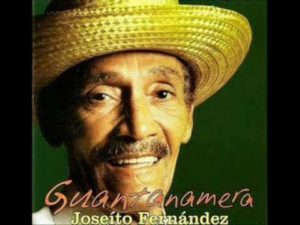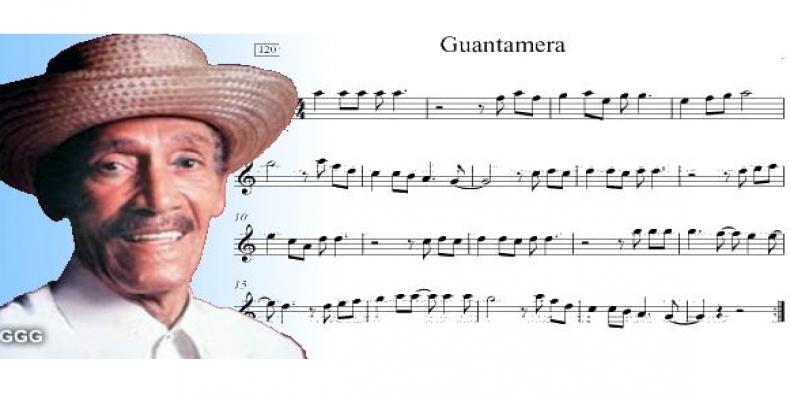“LA GUAJIRA GUANTANAMERA” DE JOSEÍTO FERNÁNDEZ.
Debido a la creación de Joseito Fernández, “La Guajira Guantanamera” en la actualidad constituye un símbolo de cubanía y la creación musical cubana más universalmente difundida.
Joseíto Fernández, nació el 5 de septiembre de 1908 en el barrio de Los Sitios, en La Habana. Desde muy joven su vida se interrelaciona con la música. Ya a los 12 años solía cantar al participar en su zona de residencia, en unión de amigos, en serenatas. Después formó parte de tríos con jóvenes aficionados e integró seguidamente varias orquestas. También por esa época realizaba las funciones de zapatero, para lograr su sustento económico.
En 1928 compuso la Guantanamera pero no es hasta casi una década después que dicha melodía cobra cierta celebridad cuando fue incluida como tema de despedida de la orquesta de Alejandro Riveiro en la que él cantaba.
PORQUÉ SE LLAMÓ “GUAJIRA GUANTANAMERA”
Incluso Joseíto nunca viajó a la ciudad de Guantánamo. El hecho que finalmente resultara conocida como Guajira guantanamera se debió a un hecho aparentemente simple. Él explicó que una joven de origen guantanamero radicada en La Habana se sintió atraída por él y por lo regular asistía a las presentaciones que hacía en una emisora de radio capitalina. Entre ellos se produjo una relación, pero un día dicha joven se disgustó y dejó de asistir a la emisora. A partir de un instante se le ocurrió dedicarle el estribillo a la joven guantanamera y solía decir con particular cadencia y emotividad:
“Mi divina guajira, guajira guantanamera, guantanamera, guajira guantanamera.”
Esta canción identificó a uno de los programas más populares de CMQ desde 1943 hasta 1954. La “Guajira guantanamera”comenzó a ser utilizada con un programa de radio donde se escenificaban hechos delictivos (la crónica roja), particularmente dramáticos acaecidos en el país.
Pero es en 1943 cuando Joseíto Fernández firma contrato con la compañía del jabón Crusellas, en la CMQ, de Monte y Prado.
A partir de ese año, la “Guajira guantanamera” se cantaría solamente en el programa ‘El Suceso del Día’, no podía radiarse ni siquiera en otros horarios en la misma estación. Esto trajo como consecuencia que cuando el pueblo escuchaba el tema identificara el programa llamado popularmente “La Guantanamera”.
Las décimas las cantaban Joseíto y La Calandria. Las redactaba Chanito Isidrón. Por tratarse de un programa que trataba la cronica roja se quedó la frase famosa que refería el fallecimiento o agresión a una persona: “Le cantaron La Guantanamera”.
A partir de 1958, la Guantanamera comenzó a adquirir una connotación significativa a nivel internacional tras haber sido cantada, con la inclusión de varios de los ‘Versos Sencillos’ de José Martí que después el trovador estadounidense Pete Seeger lo haría más popular en EEUU.
Algún tiempo después, un trío de cantantes norteamericanos hizo la primera grabación comercial de La Guantanamera, la que con el decursar de poco tiempo se convirtió en un verdadero éxito internacional.
Desde entonces muchos cantantes y agrupaciones tanto cubanos como de diferentes países han incluido en sus respectivos repertorios esta creación musical de Joseíto Fernández. También múltiples personas en el mundo han bailado al compás de la Guantanamera ya que muchos espectáculos cubanos en el extranjero han concluido con esta creación musical, para cerrar con broche de oro.
Joseíto igualmente patentizó el gran significado que le atribuyese a que su Guajira guantanamera se hubiese interrelacionado con los Versos Sencillos de José Martí e incluso él también escogió varios fragmentos de dicha obra poética para brindar una versión de su creación musical.
Joseíto Fernández, falleció en La Habana el 11 de octubre de 1979 y hasta hoy el pueblo cubano dentro y fuera del país lo recuerda con afectos y admiración.
 “LA GUAJIRA GUANTANAMERA” BY JOSEÍTO FERNÁNDEZ.
“LA GUAJIRA GUANTANAMERA” BY JOSEÍTO FERNÁNDEZ.
Due to the creation of Joseito Fernández, “La Guajira Guantanamera” is currently a symbol of Cuban and more universally diffused Cuban musical creation.
Joseíto Fernández, was born on September 5, 1908 in the Los Sitios neighborhood, in Havana. Since very young his life is interrelated with music. Already at age 12 he used to sing when he participated in his zone of residence, together with friends, in serenades. Later he formed part of trios with young amateurs and later integrated several orchestras. Also at that time he performed the functions of shoemaker, to achieve their economic sustenance.
In 1928 he composed the Guantanamera but it is not until almost a decade after the melody that it takes on a certain celebrity when it was included as a farewell song by Alejandro Riveiro’s orchestra in which he sang. While the musical group interpreted the aforementioned melody, he was improvising different tenths in each presentation. From the melody began to improvise tenths, which were related to different cities and towns in Cuba where he was going to present the group that accompanied him.
WHY IT WAS CALLED “GUAJIRA GUANTANAMERA”
Even Joseíto never traveled to the city of Guantánamo. The fact that it was finally known as Guajira guantanamera was due to an apparently simple fact. He explained that a young woman of Guantanamo origin based in Havana was attracted to him and usually attended the presentations he made on a radio station in the capital. There was a relationship between them, but one day that young lady was upset and stopped attending the station. After a moment he decided to dedicate the refrain to the young Guantanamera and used to say with particular cadence and emotion:
“My divine guajira, guajira guantanamera, guantanamera, guajira guantanamera.”
And she who was listening to the program through the radio reappeared the next day at the station. Subsequently, an advertising firm hired La Guantanamera exclusively to use it in a radio program in which diverse and tragic events occurred in Cuba. This program remained in the air for 14 years.
This song identified one of the most popular programs of CMQ from 1943 to 1954. The “Guajira guantanamera” began to be used with a radio program where crime scenes were staged (the red chronicle), particularly dramatic in the country.
But it was in 1943 that Joseíto Fernández signed a contract with the soap company Crusellas, at CMQ, in Monte y Prado.
As of that year, the “Guajira guantanamera” would only be sung on the program ‘El Suceso del Día’, it could not be broadcast even at other times at the same station. This brought as a consequence that when the people listened to the theme they identified the program popularly called “La Guantanamera”.
The tenths were sung by Joseíto and La Calandria. They were written by Chanito Isidrón. Because it was a program that dealt with red criticism, it remained the famous phrase that referred the death or aggression to a person: “Le Cantaron la Guantanamera”.
As of 1958, the Guantanamera began to acquire a significant international connotation after having been sung, with the inclusion of several of José Martí’s Simple Verses that after the American troubadour Pete Seeger would make it more popular in the US.
Some time later, a trio of American singers made the first commercial recording of La Guantanamera, which with the passing of a short time became a true international success.
Since then many singers and groups both Cuban and from different countries have included in their respective repertoires this musical creation by Joseíto Fernández. Also many people in the world have danced to the beat of the Guantanamera since many Cuban shows abroad have concluded with this musical creation, to close with a flourish.
Joseíto also made clear the great significance that he attributed to his Guajira guantanamera having interrelated with the Simple Verses of José Martí and even he also chose several fragments of that poetic work to provide a version of his musical creation.
Joseíto Fernández, died in Havana on October 11, 1979 and to this day the Cuban people inside and outside the country remember him with affectionate admiration.
Agencies/Memorias Cubanas/ Victor Pérez/ Various/ Internet Photos/ YouTube/ Arnoldo Varona/ www.TheCubanHistory.com
THE CUBAN HISTORY, HOLLYWOOD.








